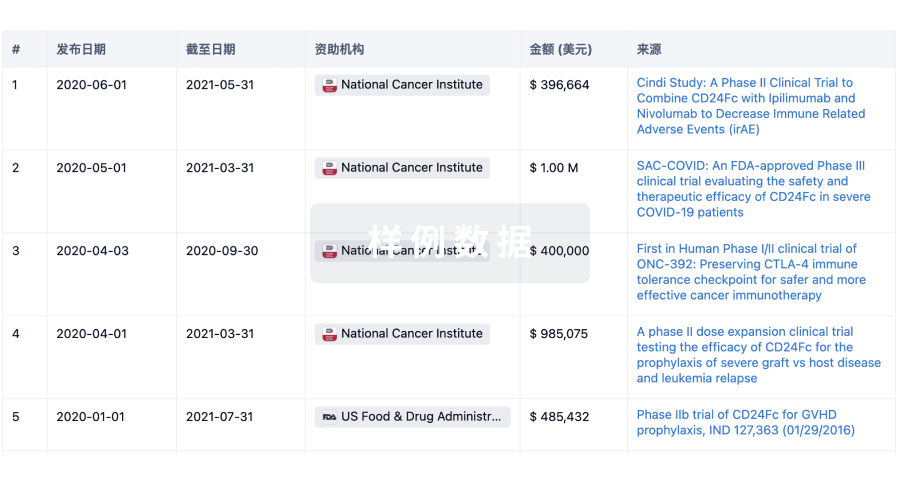预约演示
更新于:2025-05-07
First People's Hospital of Yunnan Province
更新于:2025-05-07
概览
关联
63
项与 云南省第一人民医院 相关的临床试验ChiCTR2500096196
Clinical study of atrial matrix and treatment strategy after radiofrequency ablation of atrial fibrillation
开始日期2025-02-01 |
申办/合作机构 |
ChiCTR2400088577
Efficacy of bifidobacteria treatment for chronic low back pain in patients with Modic Changes: a multicentre, double-blinded, randomised, placebo-controlled trial
开始日期2024-10-01 |
申办/合作机构 |
ChiCTR2300078746
The efficacy and safety of fully closed-loop automated insulin pump in hospitalized adults with hyperglycemia receiving enteral/parenteral nutrition
开始日期2023-12-18 |
申办/合作机构 |
100 项与 云南省第一人民医院 相关的临床结果
登录后查看更多信息
0 项与 云南省第一人民医院 相关的专利(医药)
登录后查看更多信息
2,118
项与 云南省第一人民医院 相关的文献(医药)2025-06-01·Environmental Pollution
Association of ambient ozone with time to pregnancy and the modifying effect of ambient temperature: a population-based cohort study
Article
作者: Ye, Hanfeng ; Xie, Zhengyuan ; Feng, Lin ; Song, Xiangjing ; Chen, Xing ; Zhao, Zigao ; Che, Yan ; Jiang, Yishi ; Kong, Cai ; Wang, Tao ; Zhang, Yan ; Wu, Bingxue ; Li, Yuyan
2025-06-01·European Journal of Oncology Nursing
Medication perceptions mediate the association between illness perceptions and adherence to oral anticancer agents among patients with gastrointestinal tract cancer: A cross-sectional study
Article
作者: Zhang, LiYuan ; Wei, Xulian ; Choi, Kai Chow ; Ma, Yan ; Wang, Fang ; Chen, Yongfeng ; Nam Ng, Marques Shek ; Han Chan, Carmen Wing
2025-05-01·International Journal of Biological Macromolecules
Benzeneboronic acid-modified hyaluronic acid hydrogel enhances the differentiation of dorsal root ganglion stem cells in a three-dimensional environment
Article
作者: Ma, Wei ; Gao, Hongqiang ; Bao, Wenli ; Liu, Kuangpin ; Wang, Le ; Yang, Jinwei ; Wang, Hailei ; Du, Yan ; Li, Chunyan ; Li, Liyan ; Liu, Jinhua
7
项与 云南省第一人民医院 相关的新闻(医药)2024-08-31
·复星医药
为促进血小板减少症(TCP)临床实践前沿学术与研究成果的不断推广,全面提高我国肝病、血液、肿瘤等领域TCP临床诊疗及全程管理水平,2024年8月26日,由北京中西医慢病防治促进会主办,复星医药支持的“聚肆赋能”LEAD欣时代 TCP全程管理高质量发展推进会顺利召开。
8月27日 欣升感染专列
肝病内科专场邀请河北医科大学第三医院南月敏教授、安徽医科大学第一附属医院李家斌教授担任大会主席,安徽医科大学第二附属医院邹桂舟教授、深圳市第三人民医院陈军教授、上海交通大学医学院附属第一人民医院陆伦根教授担任大会执行主席。各位主席在致辞中表示慢性肝病合并血小板减少症是临床上最常见的并发症,大多数肝硬化患者都会合并血小板减少症(TCP),给肝病的临床诊疗带来了很多困难,促进TCP全程管理的高质量发展,非常有助于提升患者生存获益。阿伐曲泊帕是中国首个获批用于慢性肝病相关血小板减少症(CLDT)的药物,为CLDT患者侵入性操作保驾护航。
欣进展篇章首先由浙江大学医学院附属第一医院黄建荣教授主持。解放军总医院第五医学中心孟繁平教授分享了“肝病相关血小板减少症临床管理共识解读”,分享了肝病相关血小板减少症的定义及患病率、病理生理、诊断及鉴别诊断、治疗等相关内容,相关临床研究证明阿伐曲泊帕拥有更优药代动力学特性,是充分平衡血小板提升后风险获益的精准选择。之后,进入第一轮巅峰对话,由上海交通大学医学院附属瑞金医院汤伟亮教授、中南大学湘雅二医院田沂教授、四川大学华西医院王丽春教授、首都医科大学附属北京地坛医院王艳斌教授、南昌大学第二附属医院席文娜教授聚焦指南共识标准及规范,结合临床应用与实践展开积极讨论,认为阿伐曲泊帕能平稳快速提升血小板计数水平,可以有效预防肝病,尤其是肝硬化治疗中可能发生的血小板减少情况。之后,由解放军总医院第五医学中心纪冬教授主持。首都医科大学附属北京佑安医院刘梅教授分享了“肝硬化择期侵入性操作合并血小板减少症患者的首选治疗药物”,从肝硬化伴血小板减少症的现状、临床危害等角度出发,指出血小板减少的存在会导致慢性肝病患者侵入性操作及手术延迟或取消,阿伐曲泊帕通过激活TPO-R促进血小板生成,可有效提升血小板计数,帮助患者平稳度过围手术期,减轻经济负担,获得国内外多项指南共识推荐。接下来,第二轮巅峰对话,由南方医科大学南方医院陈怀宇教授、⾸都医科⼤学附属北京佑安医院杜晓菲教授、安徽理工大学第一附属医院王严忠教授、安徽医科大学第二附属医院夏国美教授、昆明医科大学第二附属医院胥莹教授围绕慢性肝病、肝硬化临床血小板减少症预防与治疗等相关问题展开讨论,论证了最新学术研究与临床实践数据的可靠性,表示肝病、肝硬化患者长期服用阿伐曲泊帕可有效维持血小板计数在安全水平。
实战新篇章首先由首都医科大学附属北京地坛医院江宇泳教授主持。南京市第二医院叶伟教授分享了“实战病例-荟萃分析”,以医院诊疗病例数据为依托,结合阿伐曲泊帕临床研究最新进展,深入解读阿伐曲泊帕作用机制和临床实践效果,得出不同类型疾病研究均证实阿伐曲泊帕治疗能够有效减少有创操作前血小板输注的结论。之后,进入第一轮真知灼见,由重庆医科大学附属第二医院康娟教授、湖南省人民医院廖金卯教授、南通市第三人民医院明芳教授、南京鼓楼医院周文三教授、深圳市第三人民医院朱质斌教授针对荟萃分析数据精辟提问,从不同疾病治疗效果角度分享了各自医院应用阿伐曲泊帕预防并治疗肝硬化患者血小板减少的经验和成果,认可阿伐曲泊帕快速强效的升板效果,期待更多临床方案的推进和应用。之后,由空军军医大学唐都医院康文教授主持。吉林大学第二医院杨岚岚教授分享了“实战病例分享”,分享了一例典型肝癌肝硬化患者治疗病例,换着通过间断性口服阿伐曲泊帕有效提升肝病患者血小板计数,减少出血风险,使有创操作及手术顺利进行。接下来,第二轮真知灼见,由中南大学湘雅医院黄泽炳教授、浙江大学医学院附属第一医院连江山教授、大同市第四人民医院王鹏教授、华中科技大学同济医学院附属协和医院赵雷教授、贵州医科大学附属医院朱霞教授围绕病例治疗中血小板减少的原因、传统治疗手段优劣势及效果欠佳的原因等问题展开激烈讨论与思辨,强调了复杂病例重视MDT沟通合作的重要性,积极分享了各自TCP全程管理实践以及阿伐曲泊帕临床应用经验。
会议最后,大会执行主席邹桂舟教授、陈军教授、陆伦根教授首先总结,大会主席南月敏教授、李家斌教授压轴发言,对大会的圆满举办表示了肯定,高度赞扬了各与会嘉宾在TCP管理经验和最新技术方案应用方面的积极分享,一致认可阿伐曲泊帕在慢性肝病血小板减少的治疗中的明显优势,期待与诸位同道一起助推TCP全程管理再攀新高峰。
8月28日 欣聚介智专列
介入专场邀请西安国际医学中心消化病医院韩国宏教授、中山大学肿瘤防治中心范卫君教授、湖南省肿瘤医院向华教授担任大会主席,各位主席在致辞中表示介入治疗是微创治疗,治疗过程对血小板的数量和质量都有一定的要求,需要针对围术期的出血情况进行关注和及时干预,阿伐曲泊帕是国内首个拥有CLDT、ITP双适应症的TPO-RA,快速强效、使用安全便捷,是介入临床升血小板的良好选择。
随后,主席团及与会专家共同参与LEAD欣时代TCP全程管理高质量发展推进会点亮仪式,点亮TCP全程管理的高质量发展之路,照亮TCP患者带来康复欣希望。
热点欣篇章首先由吉林大学第一医院李佳睿教授主持。复旦大学附属中山医院刘嵘教授分享了“中期肝癌治疗策略和争议”,从TACE在中期肝癌治疗中的重要地位、中期肝癌治疗决策、TACE+规范化、精细化、个体化综合治疗等角度阐述了介入治疗在中期肝癌治疗中的重要作用,点出阿伐曲泊帕在保障介入操作,预防出血风险方面具有优良效果。之后,进入第一轮巅峰对话,由湖南省肿瘤医院李国文教授、中山大学附属第三医院李名安教授、南京市第二医院邱洁教授、解放军总医院第五医学中心张爱民教授 围绕“对中期肝癌治疗策略和争议的看法和建议”、“各中心在中晚期肝癌的最近研究数据及进展”及“对于未来肝癌治疗的展望”等话题展开讨论,分享了临床实践中有效治疗策略和辅助治疗方案,通过临床数据肯定了阿伐曲泊帕在肝癌介入治疗过程中预防和治疗TCP方面所起到的出色效果。之后,由福建医科大学附属第一医院林征宇教授主持。首都医科大学附属北京世纪坛医院王磊教授分享了“阿伐曲泊帕在肝癌介入诊疗中的价值”,通过分享经皮影像引导下穿刺活检及消融在肝癌诊疗中价值及风险、肝癌患者肝活检时的出血风险、中晚期肝癌的介入及系统治疗关注血小板全程管理的重要性等,总结得出阿伐曲泊帕具有快速强效、安全便捷的特点,是肝癌合并血小板减少症患者优选治疗药物。接下来,第二轮巅峰对话,由哈尔滨医科大学附属肿瘤医院何东风教授、常州市第一人民医院何忠明教授、广西医科大学附属肿瘤医院黄德佳教授、天津医科大学肿瘤医院司同国教授、吉林省肿瘤医院于士龙教授、解放军总医院第五医学中心周青教授围绕“阿伐曲泊帕在介入围术期的治疗经验”、“对于操作联合靶免 阿伐曲泊帕的应用分享”及“阿伐曲泊帕未来应用方向的建议及看法”等问题展开激烈对话与碰撞,分享与探讨各自中心在TCP诊疗方面的临床经验,肯定了阿伐曲泊帕快速强效、安全便捷的特性,为临床血小板减少症的诊疗提供新思路、新方案。
实战欣篇章首先由湖南省肿瘤医院古善智教授主持。浙江省肿瘤医院曾晖教授分享了“阿伐曲泊帕与部分脾栓塞治疗肝癌伴脾肿大伴血小板减少症的比较研究数据分享”,通过对阿伐曲泊帕与部分脾栓塞治疗肝癌伴脾肿大伴血小板减少症的比较研究,提示阿伐曲泊帕可作为脾栓塞的替代方案,在有出血风险的诊断或治疗操作前预防性应用,表现出良好的耐受性、安全性,并分享一例患者经阿伐曲泊帕治疗后3-5天观察到血小板计数增加,10-12天左右达峰值。之后,进入第一轮真知灼见,由云南省肿瘤医院丁荣教授、大庆市中医院付朝军教授、山西省人民医院高峰教授、湖州市中心医院纪鹏天教授、天津市肿瘤医院李勇教授、北京大学肿瘤医院徐亮教授围绕“对于课题分享的研究数据的建议及看法”及“脾栓围手术期血小板减少症管理的经验”两个问题展开讨论,聚焦研究数据进行了精准提问和点评,分享了脾栓围手术期利用阿伐曲泊帕有效预防和管理TCP的经验,表示阿伐曲泊帕让需进行有创操作的患者获得最大获益。之后,由常州市第一人民医院王祁教授主持。吉林大学第一医院吕滨教授分享了“阿伐曲泊帕在中晚期肝癌围手术期的价值研究数据分享”,分享了吉林大学第一医院单中心阿伐曲泊帕的试验研究数据、研究指出阿伐曲泊帕在改善血小板计数方面显示出优越的疗效,能有效降低出血风险,在维持肝功能方面具有潜在获益。之后通过两例病例的真实数据显示出阿伐曲泊帕起效时间快,安全性好,将成为血小板低的患者行介入操作手术的优选药物之一。接下来,第二轮真知灼见,由南昌大学第二附属医院冯龙教授、浙江大学医学院附属第二医院金凯教授、中国科技大学附属第一医院施长生教授、阜阳市人民医院谢军教授、桂林市人民医院张黎教授围绕“对相关研究数据的看法和建议”及“对于中晚期肝癌血小板减少症,如介入操作及靶免治疗的管理经验?”两个问题展开讨论,分享了介入治疗中血小板减少症相关数据和治疗经验,针对血小板减少症的危害及全程管理分享了自己的实践体会,认为阿伐曲泊帕能快速提升血小板计数,可以有效减少中晚期肝癌围手术期间的出血风险。
会议最后,王祁教授进行大会总结发言,表明本次会议内容丰富,着重聚焦于中期肝癌患者介入治疗围术期血小板减少症的全程管理进行深入探讨,通过大量循证医学证据进一步证实阿伐曲泊帕的临床疗效及安全性,为广大临床医生的诊疗工作提供了可靠安全的TCP诊疗手段,期待更多临床循证依据推动TCP全程管理的进一步落地与实施。
8月28日 欣术靶免专列
肝脏外科专场邀请复旦大学附属中山医院孙惠川教授、中山大学肿瘤防治中心陈敏山教授、中国科学技术大学附属第一医院刘连新教授担任大会主席,中南大学湘雅医院周乐杜教授、中国科学技术大学附属第一医院王继洲教授担任大会执行主席。各位主席在致辞中表示肝癌患者常并发血小板减少症,在进行各种临床操作时,有较大的出血风险,影响治疗进程,危害患者生命安全。阿伐曲泊帕可有效升高血小板,可随餐服用,安全便捷的同时,还能更加持久的维持血小板计数,在临床应用中将会造福更多患者。
欣进展篇章首先由清华大学附属北京清华长庚医院杨世忠教授主持。天津医科大学肿瘤医院张伟教授分享了“肝癌治疗进展专题”,对比术前新辅助治疗与肝癌治疗后辅助治疗的优缺点,强调夹心方案具有的明显优势,表明采用阿伐曲泊帕等措施进行术前术后TCP全程管理,能有效增加手术安全性、降低复发率。之后,进入第一轮巅峰对话,由广东医科大学附属医院陈念平教授、云南省第一人民医院晋云教授、复旦大学附属华山医院陆录教授、贵州医科大学附属医院朱海涛教授聚焦肝癌治疗进展专题进行深入探讨,分享临床实践中术前新辅助治理及术后辅助治疗的有效措施,交流采用阿伐曲泊帕进行肝癌围术期TCP全程管理的实践经验。之后,由天津医科大学肿瘤医院宋天强教授主持。曹明溶教授分享了“CLD相关血小板减少症管理优化”,介绍了我国肝病情况,指出慢性肝病相关血小板减少症疾病负担严重,亟需优化治疗选择,CLDT治疗已进入TPO-RA+时代,阿伐曲泊帕具有良好的药物结构特性和药代动力学特性,起效快,应答比例高,安全性良好、使用便捷,深受指南共识广泛推荐,现已纳入国家医保目录,是更具性价比的治疗选择。接下来,江西省肿瘤医院魏小勇教授主持并引导各位专家进行了第二轮巅峰对话,由四川大学华西医院廖明恒教授、北京大学肿瘤医院钱红纲教授、南京医科大学附属苏州医院徐敏晖教授、浙江大学明州医院徐建狄教授、中山大学附属第三医院张剑教授、中国医学科学院肿瘤医院深圳医院黄小准教授结合临床经验分享肝癌合并TCP管理模式,实践证明阿伐曲泊帕能显著提升血小板计数,真实世界研究证据显示出良好的一致性,为TCP全程管理提供了良好升板欣选择。
实战新篇章首先由解放军总医院第五医学中心朱震宇教授主持。中国科学技术大学附属第一医院宋瑞鹏教授分享了“肝外病例”,分享了1例乙状结肠癌多发肝转移治疗病例,患者术后2天出现血小板降低,口服阿伐曲泊帕治疗后,血小板提升显著,保障了围手术期安全,促进了术后肝功能的恢复。之后,南方医科大学珠江医院潘明新教授引领各讨论专家展开第一轮真知灼见,由自贡市第四人民医院陈杰教授、北京大学肿瘤医院徐达教授、江西省肿瘤医院徐国辉教授、广西医科大学第一附属医院叶新平教授围绕分享的病例进行了激烈探讨,聚焦结直肠癌肝转移强化化疗转化机会,避免大范围肝切除、保留复发后局部治疗机会,积极局部治疗,获得长期生存等问题表达了看法和建议,强调多学科协作及进行TCP全程管理的重要性。之后,由北京大学人民医院黄磊教授主持。树兰(杭州)医院庄莉教授分享了“肝移植病例”,表明肝衰竭与多器官功能衰竭重症患者治疗中均会遭遇血小板生成减少、破坏增多、消耗增加,病理生理学机制复杂多样,严重影响诊疗与预后,早期干预,采用阿伐曲泊帕联合用药,在治疗同时管理TCP,能有效提升患者治疗效果,增强生存获益。接下来,吉林大学第一医院邱伟教授主持了第二轮真知灼见,由厦门大学附属第一医院陈景熙教授、四川大学华西医院孔凌祥教授、中南大学湘雅二医院李亭教授、南京鼓楼医院彭进教授、郑州大学附属第一医院温培豪教授、昆明医科大学附属第一医院王丹教授围绕病例展开了激烈讨论,探讨重症与免疫性相关血小板低下的处理措施,分享应对肝功能突发异常的有效手段,交流如何安全开展有创诊疗,肯定了治疗中应用阿伐曲泊帕进行TCP管理,具有起效快,应答比例高,安全性良好、使用便捷等优势。
会议最后,大会主席孙惠川教授、陈敏山教授、刘连新教授进行总结发言,表示本次推进会对肝癌、肝病治疗中TCP管理难题进行了深刻剖析,并提出了创新性的解决策略,展现了极高的学术水准与前瞻性视野,肯定了阿伐曲泊帕在TCP治疗中所起到的积极效果,期待更多多学科探讨机会,进一步推动TCP全程管理高质量发展。
8月28日 欣筑血液专列
血液综合专场邀请中山大学附属第一医院李娟教授、中国医学科学院血液病医院姜尔烈教授、中国医学科学院血液病医院张凤奎教授、浙江大学医学院附属第一医院金洁教授担任大会主席,各位主席在致辞中表示原发免疫性血小板减少症(ITP)患者、再生障碍性贫血(AA)患者、接受大剂量化疗的急性白血病患者以及接受造血干细胞移植(HSCT)的患者均会遭遇血小板减少情况,阿伐曲泊帕应答率高、疗效稳定,能有效改善出血症状,不会额外增加不良风险,是血液科临床预防血小板减少症的优选方案。
欣进展篇章首先由北京大学人民医院王昱教授主持。北京大学人民医院唐晓文教授分享了“EMBT&EHA-国际前沿解读”,分享了2024年EBMT&EHA血小板减少症、再生障碍性贫血、造血干细胞移植领域精选文献,深入解读了有关阿伐曲泊帕的最新进展,研究显示阿伐曲泊帕可提高患者有效性、便捷性、总体满意度,且不良反应发生较少。之后,进入第一轮巅峰对话,由南方医科大学珠江医院贺艳杰教授、南昌大学第二附属医院李慧慧教授、福建医科大学附属协和医院李晓帆教授、中国医学科学院血液病医院彭广新教授、上海市第一人民医院童茵教授、安徽省安庆市立医院吴有智教授围绕临床患者血小板管理中的痛点和难点及对于未来TPO- RA的研究方向的意见及建议两个问题展开讨论,围绕前沿学术成果和临床实践表明阿伐曲泊帕在儿童ITP领域、AA领域、移植后植入不良领域具有潜在优势。之后,由南方医科大学珠江医院李玉华教授主持。广州市第一人民医院陈小卫教授分享了“阿伐曲泊帕是TCP标准治疗划时代欣选择”,表示TCP是临床常见病症,治疗管理仍存在诸多不足,阿伐曲泊帕在多领域TCP治疗当中拥有丰富证据,具有良好的安全性和依从性,是TCP治疗的优选。接下来,第二轮巅峰对话,由哈尔滨医科大学附属第二医院常玉莹教授、苏州大学附属第一医院顾斌教授、中国医学科学院血液病医院隋伟薇教授、上海交通大学医学院附属瑞金医院祝洪明教授围绕阿伐曲泊帕在临床实践中的经验及建议及临床工作中,优选阿伐曲泊帕的患者类型两个问题展开讨论,表明治疗ITP升板迅速,联合IST治疗SAA患者血液学反应早,转换治疗TPO-RA难治性AA疗效优异,治疗CTIT具有促进血小板恢复的潜力,治疗 HSCT 后血小板减少症缓解率高,可有效促进allo-HSCT术后血小板恢复、提高生存率,在血液疾病的TCP管理中极具实力和潜力。
实战新篇章首先由中国科学技术大学附属第一医院王兴兵教授主持。中国医学科学院血液病医院王轶教授分享了“实‘例’绽放”,分享了一例弥漫大B细胞淋巴瘤治疗后血小板减少的原因辨析及治疗,阿伐曲泊帕是没有金属螯合基团和肝毒性基团的TPO-RA,保证药效的同时兼顾安全性,对ITP疗效显著。之后,进入第一轮真知灼见,由江苏省中医院李峻教授、北京京都儿童医院刘红艳教授、空军军医大学第二附属医院秦炜炜教授、东台市人民医院王小勇教授、南通大学附属瑞慈医院徐红新教授、中国医学科学院血液病医院翟卫华教授围绕病例展开了激烈的讨论,以临床实践和诊疗经验为基础,围绕患者出现血小板下降原因、治疗相关不良事件的发生机制、治疗策略、疗效一致性等内容进行了经验交流与思想碰撞,分享TCP全程管理实践以及阿伐曲泊帕临床应用。之后,由河北燕达陆道培医院卢岳教授主持。成都医学院第一附属医院曹璐佳教授分享了“‘欣’路‘例’呈”,带来阿伐曲泊帕在慢性肝病、ITP、CTIT等疾病中的临床病例,指出阿伐曲泊帕在多个领域的治疗当中拥有丰富的临床证据,展示了较好的疗效。接下来,第二轮真知灼见,由浙江大学医学院附属邵逸夫医院杜华平教授、中国医学科学院血液病医院郭晔教授、吉林大学第一医院梁新悦教授、武汉协和医院仲照东教授以病例为中心,分享了各自在相关血液病治疗中的有效方案,探讨了慢性肝病的患者停药后血小板反复下降的解决办法与临床经验,表示阿伐曲泊帕获批ITP适应症,为患者带来了高效、可及、经济的治疗方案。
会议最后,大会主席李娟教授、姜尔烈教授、张凤奎教授、金洁教授进行总结发言,指出当前血液科TCP诊疗仍然面临巨大挑战,亟需我们从多角度出发,采取创新策略,对TCP进行全程管理。推进会的开展,不仅加深了与会者对TCP诊疗和临床实践的理解,也为未来TCP全程管理的高质量发展提供了宝贵的指导和思路。
2024-06-26
WEDNESDAY, June 26, 2024 -- The Bristol
Rheumatoid Arthritis
Fatigue
Multi-Dimensional Questionnaire (BRAF-MDQ) and Brief Fatigue Inventory (BFI-C) scores show consistency in assessing fatigue with rheumatoid arthritis (RA), according to a study published online June 14 in
Immunity, Inflammation and Disease
.
Jun Zhou, from the Affiliated Suqian First People's Hospital of Nanjing Medical University in China, and colleagues assessed fatigue with RA by two scales and validated their consistency. Analysis included 160 patients with RA and 60 healthy controls.
The researchers found that the BRAF-MDQ and BFI-C scores were significantly elevated in RA patients versus healthy controls. There was a positive and significant correlation between BRAF-MDQ global fatigue score and BFI-C global fatigue score in both RA patients (r = 0.669) and healthy controls (r = 0.527). There was a high consistency between BRAF-MDQ and BFI-C global fatigue scores in RA patients (W = 0.759) and healthy controls (W = 0.933) using the Kendall's tau-b test. Higher education level (В = −4.547) and swollen joint count (В = 1.965) independently were associated with BRAF-MDQ global fatigue score. Higher education level (В = −0.613) and clinical disease activity index (В = 0.053) independently linked with BFI-C global fatigue score.
"Exploring the risk factors of fatigue for early management is of great significance for the treatment of RA patients," the authors write.
Abstract/Full Text
Whatever your topic of interest,
subscribe to our newsletters
to get the best of Drugs.com in your inbox.
临床结果
2024-03-21
注:本文转自人民日报健康客户端,如有侵权,请联系删除。人民日报健康客户端通过查询国家医疗保障局的“国家谈判药品配备机构查询”栏目发现,自今年1月新版医保药品目录落地以来,发作性睡病新药替洛利生目前已在包括北京天坛医院、上海市第九人民医院、南昌大学第二附属医院、云南省第一人民医院、温州市第七人民医院等在内的几十家定点医疗机构和定点零售药店完成配备,患者可以在上述医院处方购药。发作性睡病是一种罕见的睡眠障碍疾病,于2023年被纳入我国《第二批罕见病目录》。替洛利生是我国首个获批用于治疗发作性睡病的药物,也是该领域的首个医保药。来自浙江温州的发作性睡病患者彬彬(化名),曾在海南博鳌参加过替洛利生的特许用药项目,得知该药获批上市并进入医保目录后,就第一时间去查询如何购药并成功在家门口的医院开药并获得报销。彬彬表示,“之前去博鳌用药按海外价格支付,较为昂贵,而替洛利生进医保后大幅降价,加上医保报销比例高,自费部分大大减少,现在我在家门口的温州市第七人民医院就能买到和报销新药,看病就医更加便利。”发作性睡病患者 彬彬(化名)“目前浙江省对医保国谈药的报销政策是非常好的,替洛利生自1月落地以来,我已经为20多名发作性睡病患者开出了处方,其中多半尤其是本地患者都享受到了医保报销。”浙江大学医学院附属邵逸夫医院睡眠中心执行主任张力三教授介绍。中国罕见病联盟执行理事长李林康表示,“一个罕见病在一年内相继实现治疗药物零的突破和医保药零的突破,这说明罕见病诊疗保障受到越来越多的重视。希望随着新药医保的落地,更多发作性睡病患者能早诊早治,回归社会。”···········
100 项与 云南省第一人民医院 相关的药物交易
登录后查看更多信息
100 项与 云南省第一人民医院 相关的转化医学
登录后查看更多信息
组织架构
使用我们的机构树数据加速您的研究。
登录
或

管线布局
2025年10月16日管线快照
无数据报导
登录后保持更新
药物交易
使用我们的药物交易数据加速您的研究。
登录
或

转化医学
使用我们的转化医学数据加速您的研究。
登录
或

营收
使用 Synapse 探索超过 36 万个组织的财务状况。
登录
或

科研基金(NIH)
访问超过 200 万项资助和基金信息,以提升您的研究之旅。
登录
或

投资
深入了解从初创企业到成熟企业的最新公司投资动态。
登录
或

融资
发掘融资趋势以验证和推进您的投资机会。
登录
或

Eureka LS:
全新生物医药AI Agent 覆盖科研全链路,让突破性发现快人一步
立即开始免费试用!
智慧芽新药情报库是智慧芽专为生命科学人士构建的基于AI的创新药情报平台,助您全方位提升您的研发与决策效率。
立即开始数据试用!
智慧芽新药库数据也通过智慧芽数据服务平台,以API或者数据包形式对外开放,助您更加充分利用智慧芽新药情报信息。
生物序列数据库
生物药研发创新
免费使用
化学结构数据库
小分子化药研发创新
免费使用